Hard water can be a curse on the
plumbing system in your home. It causes blockages, decreases the pipe’s carrying capacity and builds additional pressure, eventually leading to cracks in the water line. Fortunately, there are some tips and tricks to prevent mineral accumulation playing havoc with your plumbing.
Testing for Hard Water:
Before taking any measures, you need to know whether you have hard water or some other water quality issue. Hard water simply has a high level of magnesium and calcium, which form limescale. This type of scale accumulates inside appliances and plumbing leading to mechanical failure, reduced water pressure, and blockages. Hard water can also cause deposits to stick to porcelain, glass, enamel, tile, chrome, china and stainless steel.
The most common indications of a hard water problem include sticky residues and soap scum in your sinks and tub, mineral spotting on fixtures and soap and shampoo products being hard to lather. For final confirmation of hard water, there are hard water testing kits available, or you can consult a plumber or
water specialist.
Cleaning Faucets:
Faucets can easily become encrusted with scale and mineral accumulation. This can reduce water pressure and cause a blockage. Fortunately, cleaning is fairly straightforward. A mixture of vinegar and water is usually sufficient to loosen the scale, allowing you to slowly scrub away any traces that remain. For stubborn accumulation and scale, you can place white vinegar in a plastic bag and tie it over the faucet to soak overnight. The next morning, simply rinse with warm water and use a soft cloth to polish.
Cleaning Showerheads:
Showers can be another area of your home that can suffer from mineral accumulation. Scale can form on showerheads, making your water pressure drop. There are two options to clean these items and restore a bright finish. The first is to use a mixture of ½ cup of bleach or ammonia with 2 cups of water. You will need to wear gloves and eye protection when handling this mixture and wear old clothing that you are not bothered about staining. Even a drop of bleach can affect the color of your clothing, so take care to wear old clothes. Remove the showerhead and place it in the mixture and allow it to soak for approximately 15 minutes.
The other option is to use the white vinegar solution you used on your faucets. This will require that your showerhead is soaked for approximately 30 minutes. Either method will require that you thoroughly rinse your showerhead and run water through it for at least two minutes after it has been reinstalled. This will ensure that all the cleaning solution is removed before you use it for bathing.
It is critical that you choose one cleaning method or another. Bleach, ammonia, vinegar and other cleaning materials should never be mixed as it can create toxic fumes.
A Lasting Solution:
While these cleaning methods can be very effective, if you want a more lasting solution, you should consider installing a water softener. This will eliminate the magnesium and calcium particles from your water supply, to prevent hard water issues around your home.
By Giovanni Longo President Flood Brothers Plumbing
Giovanni Longo is a 3rd generation master plumber who has been practicing his craft and trade in the greater Los Angeles area for well over a decade and a half. A plumbing and hydraulics-engineering innovator, Giovanni’s particular world-class expertise focuses on dealing with challenging sewer system designs as well as resolving complex commercial and residential draining issues. As a certified Flood Mitigation expert, he is also well versed in a wide variety of water damage and remediation solutions





